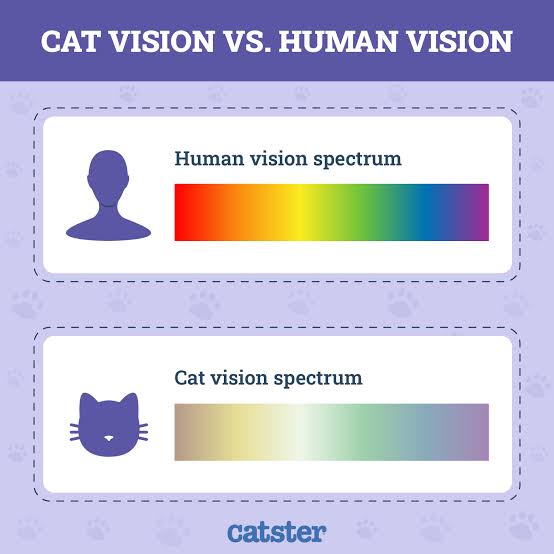You see beautiful things around you in different colors that make you feel happy and reduce your stress. You look at greenery to relax your eyes, and rainy days lift your mood emotionally. One thing you might wonder is whether all the colors and objects around us appear the same in a cat’s vision.
Many questions might arise in your mind, such as: Can cats see color? What is a cat’s favorite color? Is a cat’s eyesight poor?
In this article, we will explore how to find the best toys for cats based on their vision and how to train your cat for specific tasks, like using the litter box, drinking water, and reducing stress. We’ll also answer all your questions.
Can cats see colors?
Yes, cats can see colors, but not in the same way humans do. In the retina, there are cells called “cones” that help humans and other animals perceive colors. Humans have three types of cones, allowing us to see a range of colors, including red, green, and blue, which makes us trichromatic. In contrast, cats are dichromatic, meaning they have only two types of cones and can primarily see shades of green and blue. Read About kidney disease in cats
Cats lack the cone needed to perceive red. This doesn’t mean they are completely colorblind; rather, they cannot distinguish red, which appears gray in their vision. You might wonder, are there humans who see colors like cats? Yes, some humans with red-green color blindness see colors similarly to cats. They can only perceive shades of blue and green, while red and pink appear gray or darker. Additionally, in a cat’s vision, purple may appear as a shade of blue.
To sum it up, cats can see colors, but not the same way humans do. Some colors that humans see appear differently to cats, such as red, which looks gray to them.
How Cats See Compared to Humans
Cats and humans see the world very differently due to differences in vision. As we discussed earlier, cats are dichromatic, meaning they can see a limited range of colors. Research shows that cats can perceive green and blue accurately, but not pink, red, or purple. In contrast, humans are trichromatic and can see a wide range of colors, including red, green, and blue.
The vibrant colors that we see and enjoy appear muted to cats, which means they don’t rely on color vision as much as humans do. Cats’ vision is optimized for detecting movement and seeing in low-light conditions. Since their vision is adapted for low light, they can see much better in the dark than humans. Many vets and experts agree that cats can see 5.5 to 7 times better than humans in low-light conditions. Read Also can a dog get a cat pregnant
Cats also have larger corneas and pupils compared to humans, which allows more light to enter their eyes in dim settings. Additionally, they have a reflective layer behind the retina called the tapetum lucidum, which reflects light back through the retina, giving them a second chance to detect any light entering their eyes.
Felines can see much better than humans in low light, but their ability to see fine details, especially at a distance, is not as sharp as ours. Humans have better visual acuity, meaning we can focus on objects with more clarity and detail. A human with perfect vision typically has 20/20 vision, while, according to Dr. John, a cat’s vision is estimated to be around 20/100 to 20/200. This means that what a human can see clearly at 90 feet, a cat would need to be much closer to in order to see with the same clarity. Read more here
Cats have a wider field of view compared to humans. While humans have a visual field of about 180 degrees, cats can see roughly 200 degrees. This broader range gives them an advantage in detecting movement and spotting potential threats or prey from the sides of their vision.
What Colors Can Cats See?
Cats primarily see in shades of two colors, blue and green, which helps them distinguish certain colors that might be important in their environment. For instance, they can likely see blue skies or green grass more clearly than reds or oranges. Their eyes are more attuned to detecting movement and contrast, which helps them catch prey or react to sudden movements, even if the object’s color isn’t clearly visible.
How Does This Affect a Cat’s Daily Life?
A cat’s limited color vision doesn’t hinder its ability to live a full life. They depend on their other senses, such as smell and hearing, to observe the world. Their acute ability to detect movement and their sharp night vision are much more crucial to their survival and daily activities than seeing a wide range of colors. Learn garlic shock
For example, when a cat is playing with a red toy, it might not see the bright color as we do, but it can detect the movement of the toy easily. Similarly, when a cat is in a dimly lit room, it can see much better than humans can, thanks to its ability to capture more light through its large pupils and specialized retina.
Is a Cat’s Eyesight Bad?
No, a cat’s eyesight is not poor; in fact, it’s quite impressive in many ways. Their eyes are adapted for hunting and low-light conditions, providing them with excellent peripheral vision and superior night vision.
However, they do have some limitations compared to human vision, such as a narrower range of color perception and difficulty focusing on objects that are very close.
Featured image credit goes to catster



